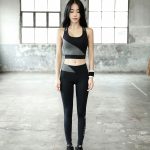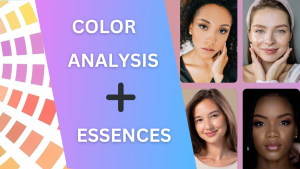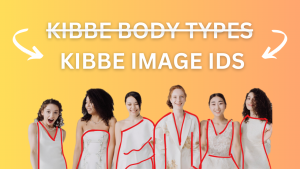
Kibbe Body Types explained
- by Luisa D.
- November 16, 2025
- Kibbe Image IDs, Style Tools
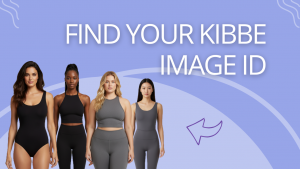
This guide uncovers what the Kibbe System is about, how to look at it since 2025, and how to find your own Kibbe Image Identity.
Info
To improve the visibility of this article I am going to use the term “Kibbe Body Types.” Please keep in mind that this is not the name David Kibbe prefers. This article explains why Kibbe Image Identities is his preferred version.
1. The Kibbe System
1.1 The Roots of the System
For decades, fashion advice has been built on the idea that certain body shapes are better than others. Magazines and online guides often suggest how to balance wide hips or create curves where there are none. This way of thinking assumes that an ideal body shape exists and that anything different needs to be corrected.
Originally introduced by David Kibbe in the 1980s, the Kibbe System offered a completely new way of looking at female bodies. Kibbe introduced a way of dressing that would complement your body instead of judging it and attempting to hide so-called problem areas. In fashion history, this approach to looking at yourself was pretty revolutionary.

1.2 How to work with it today
Over the past few years, the system has found a second life online. Forums, videos, and social media are filled with people trying to figure out whether they are Flamboyant Naturals, Dramatic Classics, or Soft Gamines. However, there have also been some misconceptions.
In January 2025, David Kibbe released his new book The Power of Style: A Guided Journey to Help You Discover Your Authentic Style, in which he updated the system.
There are no more detailed clothing recommendations. Instead the focus lies on your personal line, a drawing of your complementary silhouette. By figuring out your personal line you will ultimately also discover your Kibbe Image ID formerly known as your Kibbe Body Type.
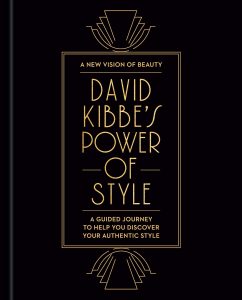
2. Your Yin Yang Balance
Before we look closer at the IDs, it is important to understand the concept that forms the foundation of the entire Kibbe System: the balance between Yin and Yang.
Yin and Yang is not about femininity or masculinity in a social sense but rather about your physical impression and visual energy.
- Yin represents softness and roundness. It is expressed through gentle curves, smaller bone structure, and an overall impression of subtle movement.
- Yang, on the other hand, stands for sharpness and elongation. It is seen in angular features, straight lines, and a sense of verticality in the silhouette.
Keep in mind these are two sides of beauty. None of these is better than the other. However, it is important to understand the difference to find out if your body leans more Yin or Yang or is actually a mix of both.
Understanding where you fall on this spectrum helps you read your Personal Line more clearly. When you recognize how much Yin or Yang your body expresses, it becomes easier to see how your silhouette manifest itself. Which will lead to your Kibbe Image ID.

3. How to Find Your Kibbe Body Type
Step 1: Mental Preparation
Before you begin identifying your Image ID, it is important to prepare mentally. In his recent book, Kibbe clarifies that it is impossible to look at yourself completely objectively. We all have preconceptions. Maybe you have been told your shoulders are too wide in the past. Or maybe you never felt curvy enough.
When you try to DIY your Kibbe Image ID, it is crucial to let go of these preconceptions. This is why Kibbe invites you to play several games within the book that help free your thinking from preconceptions before even looking at your body.
I highly recommend following along with these games. It can also be beneficial to take a moment and write down how you felt about your body in the past. Visualizing your current or past preconceptions can help when you evaluate your line drawing later. You become aware of possible blind spots and can try to remove them as much as possible.
Step 2: Taking Your Photo Correctly
This is a very important part of figuring out your personal line and best silhouette.
You will need a clear, full-body image without distractions. Wear form-fitting clothing such as a leotard, swimsuit, or close-fitting top and leggings. Avoid loose or structured clothing. Use natural, even lighting and a neutral background. Remove shoes and accessories.
Stand in a relaxed, neutral pose with your feet about three inches apart and arms resting naturally at your sides. Keep your posture upright but not tense. Take the photo straight from the front, at chest height, from about ten feet away. If possible, have someone else take the photo.
Do not use a mirror! Very important. Mirror selfies will distort your proportions and are not useful for this purpose.

Step 3: Creating and Interpreting Your Line Sketch
Online I see a lot of people confused about how to draw your personal line. Here’s how to do it.
At first, imagine a very light layer of silk chiffon weighted at the bottom draping over your body. Observe how it falls from the edge of your shoulders, whether straight down or slightly curved. This observation will guide your line sketch.
This means the goal of the sketch is not to outline your body but to trace how the imaginary fabric drapes.
Then you are looking for your dominant and additional characteristic, the two elements that form your personal line.
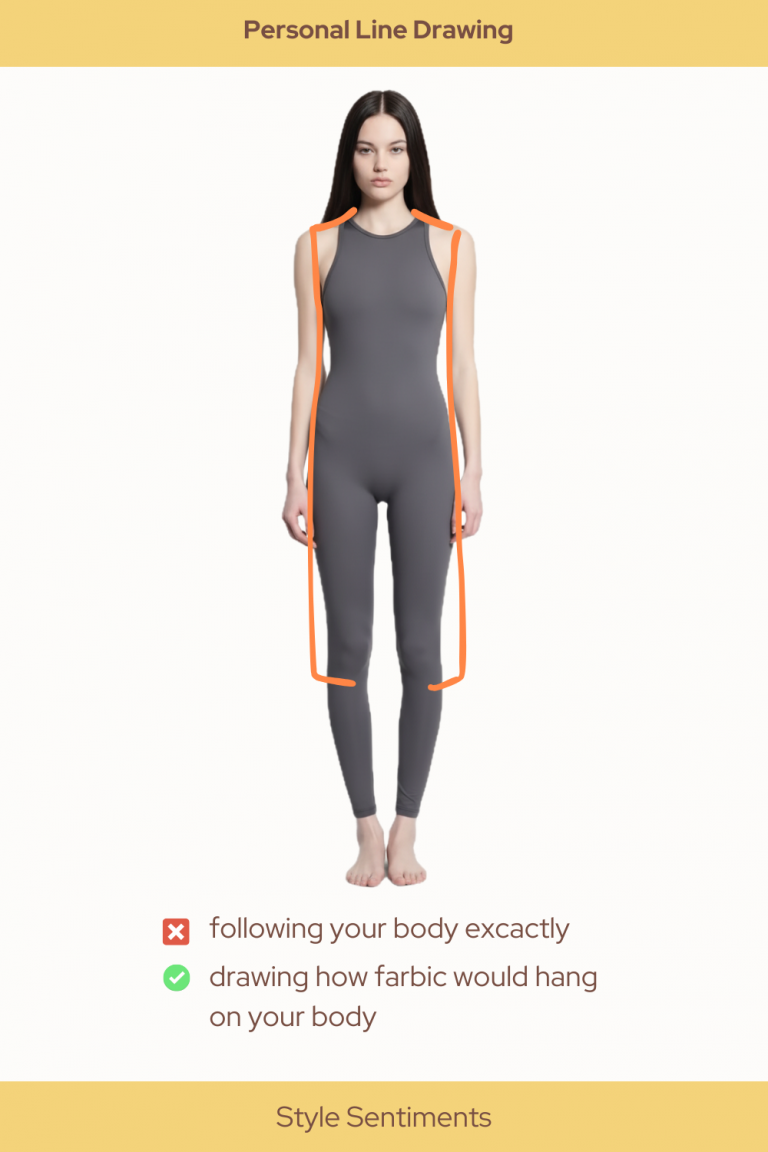
Step 4: Finding Your Dominant
Your dominant describes the overall direction of your lines. It is about tracing where your eye travels when people look at your body. Does your eye go straight down, or does it follow your curve?
Vertical lines are long, straight, and elongated (yang). Curved lines are soft, rounded, or flowing (yin).
- If the line moves straight down, your dominant is vertical.
- If it pushes out around the bust or hips, your dominant is curve.
If you are over five feet six inches, vertical naturally becomes part of your dominant line.
Keep in mind that Kibbe Curve doesn’t necessarily mean having a big bust or not. It is rather about how it is placed. When you draw your personal line. Does your bust push out the fabric towards the side? This will define if you have Kibbe Curve or not.
Step 5: Defining Your Additional
Your additional describes how your dominant interacts with another quality.
The additional could be curve, moderate, width, narrow, double curve, or petite.
Your personal line is the combination of dominant and additional. Together they describe how fabric interacts with your body.
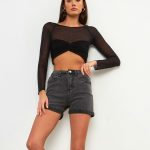
Width
The upper body (shoulders and upper torso) is broader than the area below. This doesn’t mean the body is wide overall, just proportionally wider.

Curve
There is an oval line cutting in at midsection.

Moderate
The outer edge of the upper body and the hipbone are in balance, these areas are evenly aligned.

Petite
A compact body type. Either a Vertical or Curve shape that fits into a smaller, more condensed frame.

Double Curve
Two oval shapes: one at the bust, one at the hips, with a clear inward curve between them (at the waist).

Narrow
The body goes inward from the shoulders downward. It may go straight down or curve slightly out, but it always stays within the shoulder line.
Your Image ID
Once you have your dominant and additional lines, you can identify your Image Identity. The ten Image Identities are Dramatic, Soft Dramatic, Flamboyant Natural, Soft Natural, Dramatic Classic, Soft Classic, Flamboyant Gamine, Soft Gamine, Theatrical Romantic, and Romantic.
This part is the one most people are looking forward to. Nonetheless, Kibbe emphasizes that the process is more important than labeling yourself. It is mainly about understanding your body without preconceptions not just giving it a name.
Heres the combo of dominant and additional characteristic and which Image Identity lies behind it.

4. How to Dress for Your Kibbe Body Type
Now you know your Kibbe Image ID and you might wonder, how to use it when getting dressed.
Again, Kibbe minimized strict clothing recommendations in his new book. The most important guide you have gor creating harmonious outfits is your personal line. The goal is to build an outfit that follows these lines. You are basically imitating the way your body flows already.
Kibbe incourages you to think head to toe in terms of creating outfits rather than thinking about individual pieces. It is about how your whole outfit works together.
Your dominant and additional characteristics can act as guide when getting dressed. It is the two most crucial aspects for you to keep in mind when getting dressed.
For example, a Dramatic should focus on elongated narrow silhouettes, a Soft Dramatic on elogated silhouette that follow your curves and so on.
At first the Kibbe system can seem pretty complex. I hope this guide was helpful. Have fun experimenting with your personal style.
